人教版初三英语教案-中考总复习动词时态一 基础讲解
- 格式:doc
- 大小:392.50 KB
- 文档页数:4
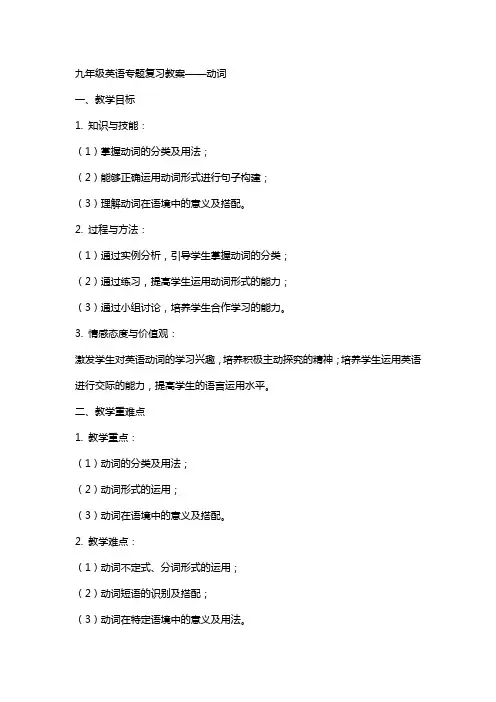
九年级英语专题复习教案——动词一、教学目标1. 知识与技能:(1)掌握动词的分类及用法;(2)能够正确运用动词形式进行句子构建;(3)理解动词在语境中的意义及搭配。
2. 过程与方法:(1)通过实例分析,引导学生掌握动词的分类;(2)通过练习,提高学生运用动词形式的能力;(3)通过小组讨论,培养学生合作学习的能力。
3. 情感态度与价值观:激发学生对英语动词的学习兴趣,培养积极主动探究的精神;培养学生运用英语进行交际的能力,提高学生的语言运用水平。
二、教学重难点1. 教学重点:(1)动词的分类及用法;(2)动词形式的运用;(3)动词在语境中的意义及搭配。
2. 教学难点:(1)动词不定式、分词形式的运用;(2)动词短语的识别及搭配;(3)动词在特定语境中的意义及用法。
三、教学方法1. 情境教学法:通过设置各种真实的语境,让学生在实际情境中学习、运用动词;2. 任务型教学法:设计各种任务,让学生在完成任务的过程中,提高运用动词的能力;3. 小组合作学习:引导学生分组讨论,共同探究动词的用法,培养学生的合作意识。
四、教学过程1. 导入:通过提问方式引导学生回顾已学过的动词知识,为新课学习做好铺垫;2. 讲解:讲解动词的分类、用法及动词形式的变化;3. 练习:设计各种练习题,让学生在实践中掌握动词的用法;4. 拓展:介绍动词的搭配及语境意义,引导学生学会运用;5. 总结:对本节课的内容进行总结,强调重点知识。
五、课后作业1. 整理本节课所学的动词知识点,形成笔记;2. 完成课后练习题,巩固所学知识;3. 搜集动词搭配的实例,进行学习交流。
六、教学评价1. 课堂表现:观察学生在课堂上的参与程度、提问回答等情况,了解学生的学习状态;2. 练习完成情况:检查学生课后练习的完成质量,评估学生对动词知识的掌握程度;3. 小组讨论:评价学生在小组合作学习中的表现,包括交流、合作、探究等方面;4. 课后反馈:收集学生的学习反馈,了解学生在学习过程中遇到的问题,为下一步教学提供参考。
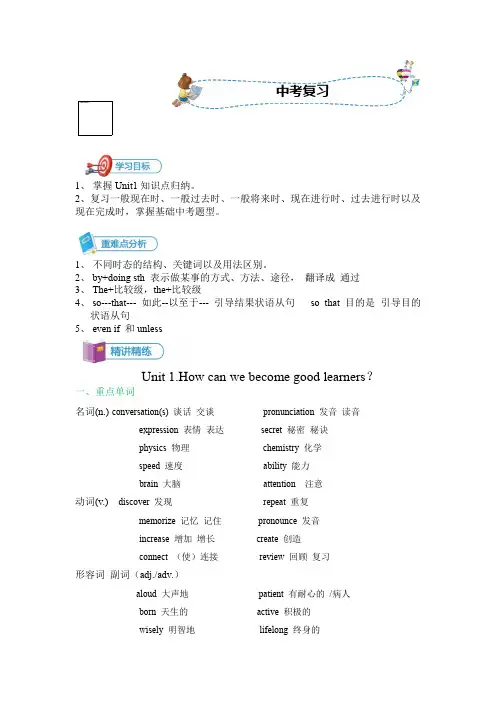
中考复习1、掌握Unit1知识点归纳。
2、复习一般现在时、一般过去时、一般将来时、现在进行时、过去进行时以及现在完成时,掌握基础中考题型。
1、不同时态的结构、关键词以及用法区别。
2、by+doing sth 表示做某事的方式、方法、途径,翻译成通过3、The+比较级,the+比较级4、so---that---如此--以至于---引导结果状语从句so that 目的是引导目的状语从句5、even if 和unlessUnit 1.How can we become good learners?一、重点单词名词(n.)conversation(s) 谈话交谈pronunciation 发音读音expression 表情表达secret 秘密秘诀physics 物理chemistry 化学speed 速度ability 能力brain 大脑attention 注意动词(v.) discover 发现repeat 重复memorize 记忆记住pronounce 发音increase 增加增长create 创造connect (使)连接review 回顾复习形容词副词(adj./adv.)aloud 大声地patient 有耐心的/病人born 天生的active 积极的wisely 明智地lifelong 终身的二、重点知识点1.ask的用法(课文:by asking the teacher for help)ask(sb)for help----I study by asking my classmates for helpask sb (not)to do让某人做(不做)某事------He asked her to stay with him.2.have conversations with sbin+语言表示用某种语音------Please speak it in Chinese.eg: Do you have conversations with your friends in English(用英语)?3.What about+doing?=How about doing? =Why not do?=Why don’t you do?都是用来提建议的句型eg:What about listening to tapes?4.a little 有一点儿后+形容词-------I’m a little nervous.= kind of后+不可数名词------There is a little water in the bottle.5.finish doing sth 完成做某事give a report 作报告类似:practice doing sth-------How do you practice speaking?eg:I have to finish reading a book and give a report next Monday.6.word by word 一个字一个字地by 表示连续或者反复one by one 一个接一个step by step 一步一步地year by year 年复一年little by littleeg:Don’t read word by word .They went out of the classroom one by one.7.be afraid to do 对做某事内心感到恐惧be afraid of (doing) 害怕(做)… (内心不情愿)eg:I was afraid to ask questions because of my poor pronunciation。
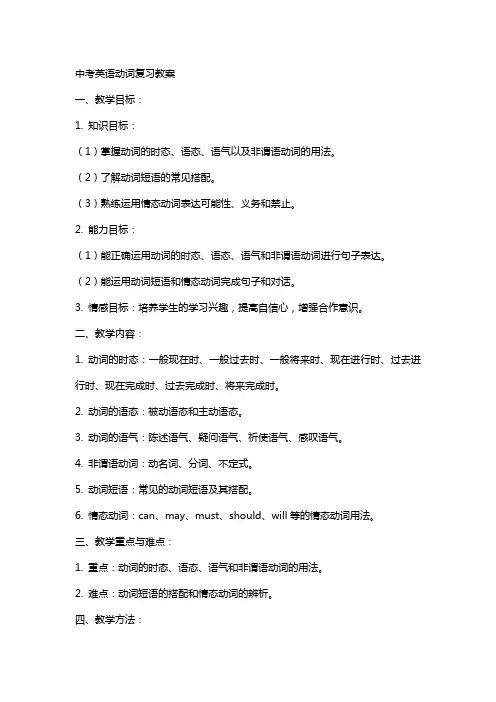
中考英语动词复习教案一、教学目标:1. 知识目标:(1)掌握动词的时态、语态、语气以及非谓语动词的用法。
(2)了解动词短语的常见搭配。
(3)熟练运用情态动词表达可能性、义务和禁止。
2. 能力目标:(1)能正确运用动词的时态、语态、语气和非谓语动词进行句子表达。
(2)能运用动词短语和情态动词完成句子和对话。
3. 情感目标:培养学生的学习兴趣,提高自信心,增强合作意识。
二、教学内容:1. 动词的时态:一般现在时、一般过去时、一般将来时、现在进行时、过去进行时、现在完成时、过去完成时、将来完成时。
2. 动词的语态:被动语态和主动语态。
3. 动词的语气:陈述语气、疑问语气、祈使语气、感叹语气。
4. 非谓语动词:动名词、分词、不定式。
5. 动词短语:常见的动词短语及其搭配。
6. 情态动词:can、may、must、should、will等的情态动词用法。
三、教学重点与难点:1. 重点:动词的时态、语态、语气和非谓语动词的用法。
2. 难点:动词短语的搭配和情态动词的辨析。
四、教学方法:1. 任务型教学法:通过完成任务,让学生在实践中掌握动词的用法。
2. 情境教学法:创设真实的语境,让学生在情境中学习动词。
3. 合作学习法:引导学生分组讨论,相互交流,提高合作能力。
五、教学过程:1. 导入:通过播放一段视频或音频,引导学生关注动词在实际语境中的运用。
2. 呈现:用PPT展示动词的时态、语态、语气和非谓语动词的图片,让学生观察并回答相关问题。
3. 讲解:讲解动词的时态、语态、语气和非谓语动词的用法,举例说明。
4. 练习:设计相关的练习题,让学生进行课堂练习,及时巩固所学知识。
5. 拓展:介绍动词短语的常见搭配,让学生进行实际操作,运用所学知识。
7. 作业布置:布置相关的作业,让学生课后巩固所学知识。
8. 反馈与评价:及时对学生的学习情况进行反馈,鼓励优秀学生,帮助后进生。
六、教学评估1. 课堂参与度:观察学生在课堂上的参与情况,包括发言、讨论、练习等。
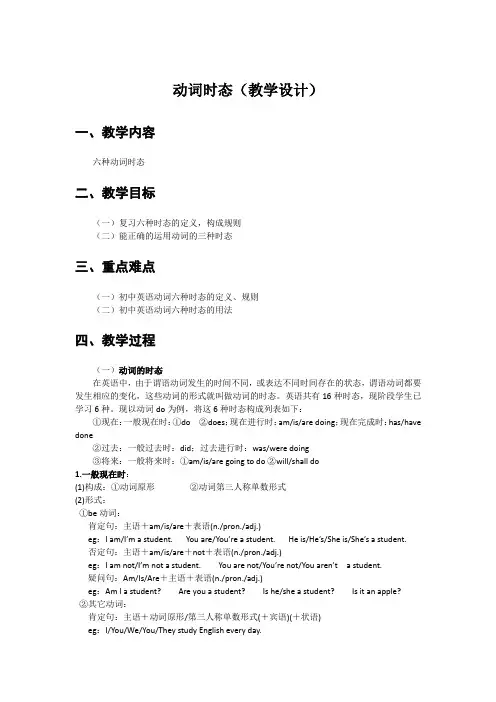
动词时态(教学设计)一、教学内容六种动词时态二、教学目标(一)复习六种时态的定义,构成规则(二)能正确的运用动词的三种时态三、重点难点(一)初中英语动词六种时态的定义、规则(二)初中英语动词六种时态的用法四、教学过程(一)动词的时态在英语中,由于谓语动词发生的时间不同,或表达不同时间存在的状态,谓语动词都要发生相应的变化,这些动词的形式就叫做动词的时态。
英语共有16种时态,现阶段学生已学习6种。
现以动词do为例,将这6种时态构成列表如下:①现在:一般现在时:①do ②does;现在进行时:am/is/are doing;现在完成时:has/have done②过去:一般过去时:did;过去进行时:was/were doing③将来:一般将来时:①am/is/are going to do ②will/shall do1.一般现在时:(1)构成:①动词原形②动词第三人称单数形式(2)形式:①be动词:肯定句:主语+am/is/are+表语(n./pron./adj.)eg:I am/I’m a student. You are/You’re a student. He is/He’s/She is/She’s a student.否定句:主语+am/is/are+not+表语(n./pron./adj.)eg:I am not/I’m not a student. You are not/You’re not/You aren’t a student.疑问句:Am/Is/Are+主语+表语(n./pron./adj.)eg:Am I a student? Are you a student? Is he/she a student? Is it an apple?②其它动词:肯定句:主语+动词原形/第三人称单数形式(+宾语)(+状语)eg:I/You/We/You/They study English every day.否定句:主语+don’t/doesn’t(第三人称单数)+动词原形(+宾语)(+状语)eg:I/You/We/You/They don’t study English every day.疑问句:Do/Does+主语+动词原形(+宾语)(+状语)eg:Do I/You/We/You/They study English every day?(3)用法:①表示经常发生的动作或现在存在的状态eg:I go to school every day except Sunday.除了星期日,我每天都上学。
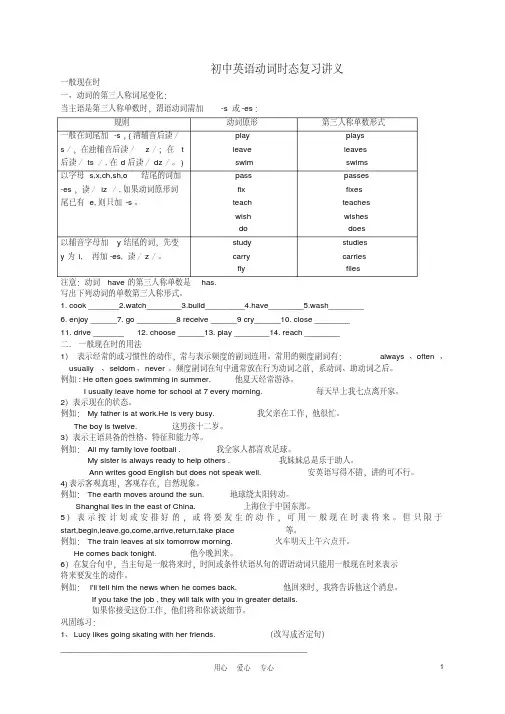
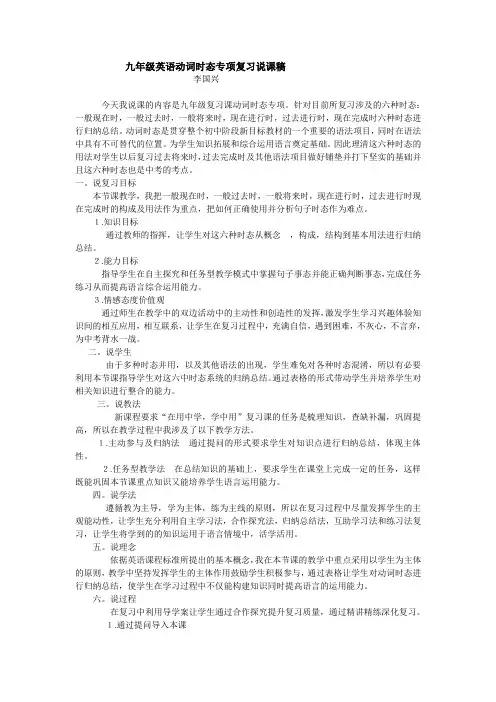
九年级英语动词时态专项复习说课稿李国兴今天我说课的内容是九年级复习课动词时态专项。
针对目前所复习涉及的六种时态:一般现在时,一般过去时,一般将来时,现在进行时,过去进行时,现在完成时六种时态进行归纳总结。
动词时态是贯穿整个初中阶段新目标教材的一个重要的语法项目,同时在语法中具有不可替代的位置。
为学生知识拓展和综合运用语言奠定基础。
因此理清这六种时态的用法对学生以后复习过去将来时,过去完成时及其他语法项目做好铺垫并打下坚实的基础并且这六种时态也是中考的考点。
一。
说复习目标本节课教学,我把一般现在时,一般过去时,一般将来时,现在进行时,过去进行时现在完成时的构成及用法作为重点,把如何正确使用并分析句子时态作为难点。
1.知识目标通过教师的指挥,让学生对这六种时态从概念,构成,结构到基本用法进行归纳总结。
2.能力目标指导学生在自主探究和任务型教学模式中掌握句子事态并能正确判断事态,完成任务练习从而提高语言综合运用能力。
3.情感态度价值观通过师生在教学中的双边活动中的主动性和创造性的发挥,激发学生学习兴趣体验知识间的相互应用,相互联系,让学生在复习过程中,充满自信,遇到困难,不灰心,不言弃,为中考背水一战。
二。
说学生由于多种时态并用,以及其他语法的出现,学生难免对各种时态混淆,所以有必要利用本节课指导学生对这六中时态系统的归纳总结。
通过表格的形式带动学生并培养学生对相关知识进行整合的能力。
三。
说教法新课程要求“在用中学,学中用”复习课的任务是梳理知识,查缺补漏,巩固提高,所以在教学过程中我涉及了以下教学方法。
1.主动参与及归纳法通过提问的形式要求学生对知识点进行归纳总结,体现主体性。
2.任务型教学法在总结知识的基础上,要求学生在课堂上完成一定的任务,这样既能巩固本节课重点知识又能培养学生语言运用能力。
四。
说学法遵循教为主导,学为主体,练为主线的原则,所以在复习过程中尽量发挥学生的主观能动性,让学生充分利用自主学习法,合作探究法,归纳总结法,互助学习法和练习法复习,让学生将学到的的知识运用于语言情境中,活学活用。
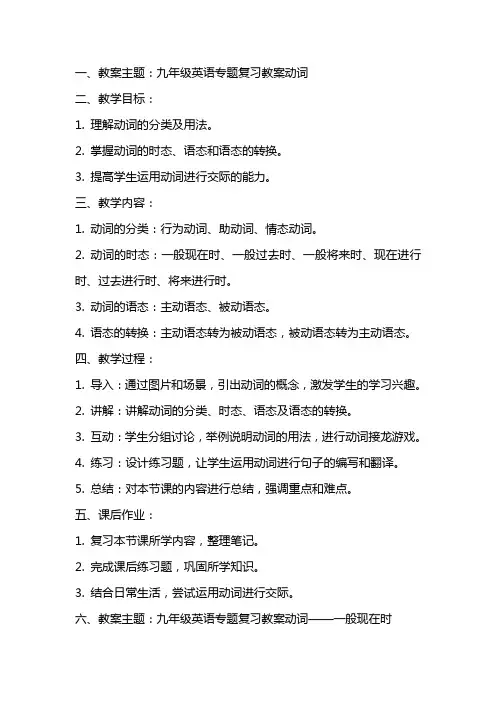
一、教案主题:九年级英语专题复习教案动词二、教学目标:1. 理解动词的分类及用法。
2. 掌握动词的时态、语态和语态的转换。
3. 提高学生运用动词进行交际的能力。
三、教学内容:1. 动词的分类:行为动词、助动词、情态动词。
2. 动词的时态:一般现在时、一般过去时、一般将来时、现在进行时、过去进行时、将来进行时。
3. 动词的语态:主动语态、被动语态。
4. 语态的转换:主动语态转为被动语态,被动语态转为主动语态。
四、教学过程:1. 导入:通过图片和场景,引出动词的概念,激发学生的学习兴趣。
2. 讲解:讲解动词的分类、时态、语态及语态的转换。
3. 互动:学生分组讨论,举例说明动词的用法,进行动词接龙游戏。
4. 练习:设计练习题,让学生运用动词进行句子的编写和翻译。
5. 总结:对本节课的内容进行总结,强调重点和难点。
五、课后作业:1. 复习本节课所学内容,整理笔记。
2. 完成课后练习题,巩固所学知识。
3. 结合日常生活,尝试运用动词进行交际。
六、教案主题:九年级英语专题复习教案动词——一般现在时七、教学目标:1. 掌握一般现在时的构成和用法。
2. 能够正确运用一般现在时描述经常性和习惯性的动作。
3. 提高学生在实际情境中运用一般现在时的能力。
八、教学内容:1. 一般现在时的构成:主语+ 动词原形。
2. 一般现在时的用法:描述经常性和习惯性的动作、状态、特点等。
3. 一般现在时的特殊句式:there be句型、疑问句、否定句。
九、教学过程:1. 导入:通过图片和场景,引导学生回顾一般现在时的概念。
2. 讲解:讲解一般现在时的构成、用法和特殊句式。
3. 互动:学生分组讨论,举例说明一般现在时的用法,进行一般现在时的句子接龙游戏。
4. 练习:设计练习题,让学生运用一般现在时进行句子的编写和翻译。
5. 总结:对本节课的内容进行总结,强调重点和难点。
十、课后作业:1. 复习本节课所学内容,整理笔记。
2. 完成课后练习题,巩固所学知识。
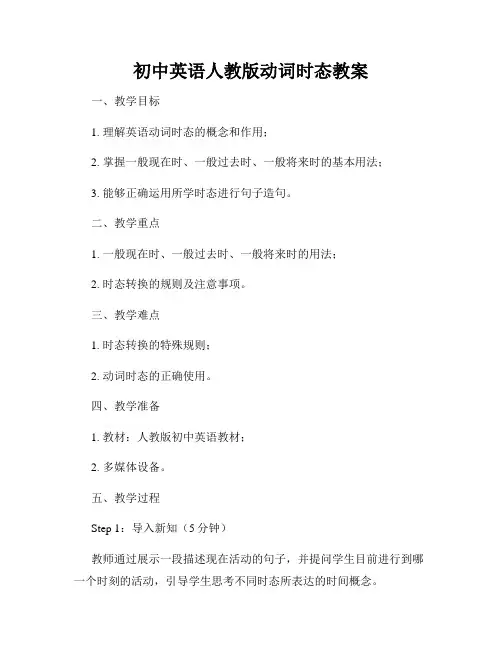
初中英语人教版动词时态教案一、教学目标1. 理解英语动词时态的概念和作用;2. 掌握一般现在时、一般过去时、一般将来时的基本用法;3. 能够正确运用所学时态进行句子造句。
二、教学重点1. 一般现在时、一般过去时、一般将来时的用法;2. 时态转换的规则及注意事项。
三、教学难点1. 时态转换的特殊规则;2. 动词时态的正确使用。
四、教学准备1. 教材:人教版初中英语教材;2. 多媒体设备。
五、教学过程Step 1:导入新知(5分钟)教师通过展示一段描述现在活动的句子,并提问学生目前进行到哪一个时刻的活动,引导学生思考不同时态所表达的时间概念。
示例:教师展示句子:"He plays football every Saturday."教师提问:"What does he do every Saturday?"Step 2:引入新知(10分钟)教师出示一张包含不同时态的表格,并解释每个时态的用法和表示的时间概念。
同时,通过例句演示不同时态的基本结构和关键词。
示例:一般现在时:主语 + 动词原形例句:She often eats fruit.关键词:often, always, sometimes一般过去时:主语 + 动词过去式例句:They watched a movie yesterday.关键词:yesterday, last week, ago一般将来时:主语 + will + 动词原形例句:I will visit my grandparents next week.关键词:next week, in the futureStep 3:练习时态转换(15分钟)教师给出一些句子,要求学生将其转换成其他时态。
学生通过思考和讨论,运用所学的知识进行转换。
示例:1. They go swimming every Sunday.(一般过去时)2. He will go to the park tomorrow.(一般现在时)3. She ate an apple just now.(一般将来时)Step 4:巩固练习(15分钟)教师分发练习题或板书习题,要求学生根据所给的语境写出正确的时态形式。
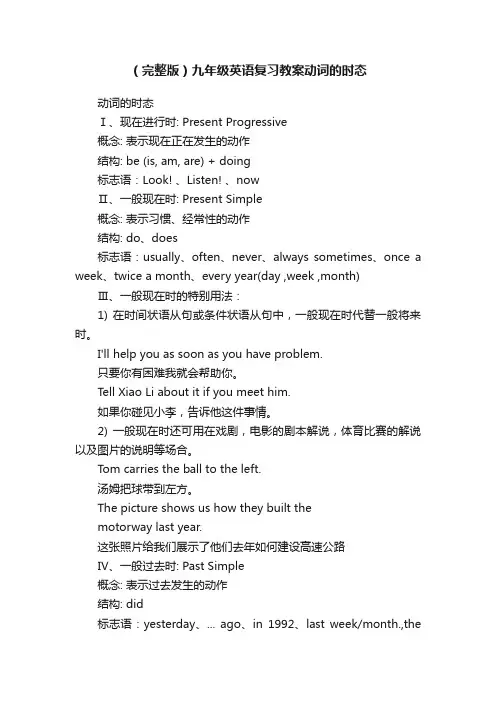
(完整版)九年级英语复习教案动词的时态动词的时态Ⅰ、现在进行时: Present Progressive概念: 表示现在正在发生的动作结构: be (is, am, are) + doing标志语:Look! 、Listen! 、nowⅡ、一般现在时: Present Simple概念: 表示习惯、经常性的动作结构: do、does标志语:usually、often、never、always sometimes、once a week、twice a month、every year(day ,week ,month) Ⅲ、一般现在时的特别用法:1) 在时间状语从句或条件状语从句中,一般现在时代替一般将来时。
I'll help you as soon as you have problem.只要你有困难我就会帮助你。
Tell Xiao Li about it if you meet him.如果你碰见小李,告诉他这件事情。
2) 一般现在时还可用在戏剧,电影的剧本解说,体育比赛的解说以及图片的说明等场合。
Tom carries the ball to the left.汤姆把球带到左方。
The picture shows us how they built themotorway last year.这张照片给我们展示了他们去年如何建设高速公路Ⅳ、一般过去时: Past Simple概念: 表示过去发生的动作结构: did标志语:yesterday、... ago、in 1992、last week/month.,theday before yesterday,the other day Ⅴ、一般将来时: Future Simple 概念: 表示将要发生的动作结构: will do、be (is、am、are) going to do标志语:tomorrow、in..、next…其他表示将来的句型(仅限于了解)1)be + going + 动词不定式。
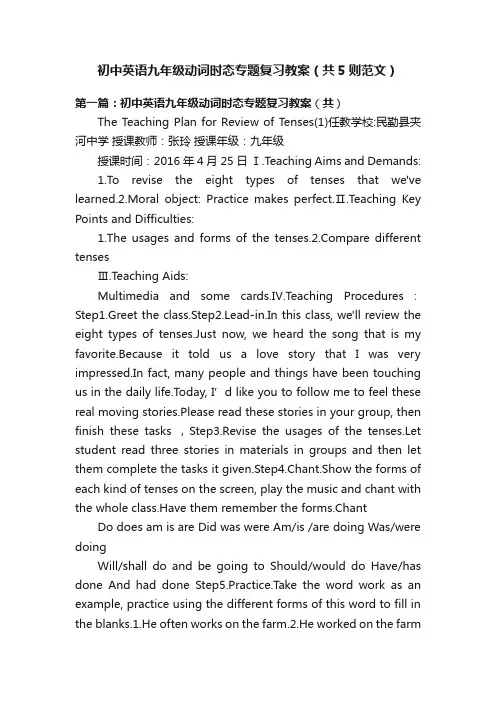
初中英语九年级动词时态专题复习教案(共5则范文)第一篇:初中英语九年级动词时态专题复习教案(共)The Teaching Plan for Review of Tenses(1)任教学校:民勤县夹河中学授课教师:张玲授课年级:九年级授课时间:2016年4月25日Ⅰ.Teaching Aims and Demands:1.To revise the eight types of tenses that we've learned.2.Moral object: Practice makes perfect.Ⅱ.Teaching Key Points and Difficulties:1.The usages and forms of the tenses.pare different tensesⅢ.Teaching Aids:Multimedia and some cards.Ⅳ.T eaching Procedures:Step1.Greet the class.Step2.Lead-in.In this class, we'll review the eight types of tenses.Just now, we heard the song that is my favorite.Because it told us a love story that I was very impressed.In fact, many people and things have been touching us in the daily life.Today, I’d like you to follow me to feel these real moving stories.Please read these stories in your group, then finish these tasks ,Step3.Revise the usages of the tenses.Let student read three stories in materials in groups and then let them complete the tasks it given.Step4.Chant.Show the forms of each kind of tenses on the screen, play the music and chant with the whole class.Have them remember the forms.Chant Do does am is are Did was were Am/is /are doing Was/were doingWill/shall do and be going to Should/would do Have/has done And had done Step5.Practice.T ake the word work as an example, practice using the different forms of this word to fill in the blanks.1.He often works on the farm.2.He worked on the farm2 years ago.3.He is working on the farm now.4.He was working on the farm those years.5.He will work on the farm next year.6.He said he would work on the farm the next month.7.He has worked on the farm for three years.8.He said he had worked on the farm for 5 years.Step6.Do some exercises.Step7.Summary.In this class, we've revised the eight types of tenses about their usages and forms.We've also do some practice about them.But it is not enough, you should do more practice.Because practice makes perfect.Study hard and try your best.I believe you will make a great success in the Entrance Examination this year.Best wishes for you!Step8.Homework.At last I'll leave some homework for you.Write an article about yourself, tell us your past, your present and your future.第二篇:浅谈初中英语动词时态教学浅谈初中英语动词时态教学英语的动词时态这一语法现象与我们母语的语法差别较大,学起来也较乏味。
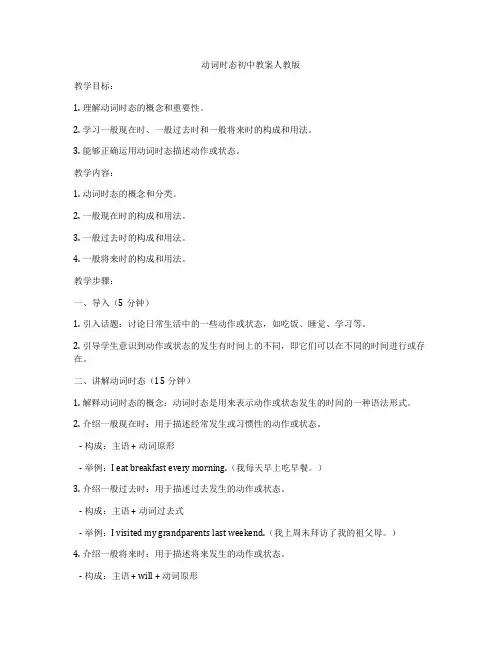
动词时态初中教案人教版教学目标:1. 理解动词时态的概念和重要性。
2. 学习一般现在时、一般过去时和一般将来时的构成和用法。
3. 能够正确运用动词时态描述动作或状态。
教学内容:1. 动词时态的概念和分类。
2. 一般现在时的构成和用法。
3. 一般过去时的构成和用法。
4. 一般将来时的构成和用法。
教学步骤:一、导入(5分钟)1. 引入话题:讨论日常生活中的一些动作或状态,如吃饭、睡觉、学习等。
2. 引导学生意识到动作或状态的发生有时间上的不同,即它们可以在不同的时间进行或存在。
二、讲解动词时态(15分钟)1. 解释动词时态的概念:动词时态是用来表示动作或状态发生的时间的一种语法形式。
2. 介绍一般现在时:用于描述经常发生或习惯性的动作或状态。
- 构成:主语 + 动词原形- 举例:I eat breakfast every morning.(我每天早上吃早餐。
)3. 介绍一般过去时:用于描述过去发生的动作或状态。
- 构成:主语 + 动词过去式- 举例:I visited my grandparents last weekend.(我上周末拜访了我的祖父母。
)4. 介绍一般将来时:用于描述将来发生的动作或状态。
- 构成:主语 + will + 动词原形- 举例:I will go to the library tomorrow.(我明天将会去图书馆。
)三、练习与巩固(15分钟)1. 填空练习:根据句子中的时间状语,选择合适的动词时态填空。
- 我每天早上喝咖啡。
(一般现在时)- 他昨天下午去游泳了。
(一般过去时)- 她明天将会参加考试。
(一般将来时)2. 小组活动:学生分组,互相编写句子,使用不同的动词时态,并让对方猜测句子的意思。
四、总结与作业(5分钟)1. 总结本节课所学的内容,强调动词时态的重要性。
2. 布置作业:让学生用所学的动词时态编写一段小故事,描述一个人一天的日常生活。
教学评价:1. 课堂参与度:观察学生在课堂上的积极参与情况和提问回答情况。
九年级科目教案深入学习中的动词时态和语态动词时态和语态是语法学习中的重要部分,对于学生在九年级阶段的英语学习来说,更是非常关键的知识点。
了解和掌握动词的时态和语态可以帮助学生正确表达时间和态度,提高语言表达的准确性和流利度。
本教案将深入学习动词时态和语态的知识,帮助学生掌握相关概念和运用。
一、动词时态的概念和分类时态是用来表示动作发生的时间的一种语法形式。
英语中的动词时态主要分为三种:一般时态、进行时态和完成时态。
1. 一般时态一般时态用来表示经常性的动作、普遍的真理、现在的状态或习惯等。
一般时态主要分为三个时态:现在时、过去时和将来时。
- 现在时:表示现在正在进行或经常发生的动作。
如:I eat breakfast every morning.(我每天早上吃早餐。
)- 过去时:表示过去已经发生的动作。
如:She went to the park yesterday.(她昨天去了公园。
)- 将来时:表示将来会发生的动作。
如:I will visit my grandparents next week.(我下周会去看望我的祖父母。
)2. 进行时态进行时态用来表示现在正在进行的动作。
进行时态由“be动词”和动词的现在分词构成。
进行时态主要分为三个时态:现在进行时、过去进行时和将来进行时。
- 现在进行时:表示现在正在进行的动作。
如:They are studying in the library.(他们正在图书馆学习。
)- 过去进行时:表示过去某个时间点正在进行的动作。
如:She was watching TV at 8 o'clock yesterday evening.(昨天晚上8点她正在看电视。
)- 将来进行时:表示将来某个时间点正在进行的动作。
如:I will be having dinner at 7 o'clock tomorrow.(明天晚上7点我将在吃晚餐。
)3. 完成时态完成时态用来表示过去某个时间点已经完成的动作。
人教版中考英语专题复习《时态专题复习》教学设计一. 教材分析人教版中考英语专题复习《时态专题复习》教材主要包括现在时、过去时、将来时和被动语态四大时态。
本节课旨在帮助学生系统地复习和掌握这四种时态的用法,提高他们的英语语法水平。
教材内容丰富,既有理论讲解,又有实例分析,还有练习题和测试题,旨在让学生在复习中不断提高。
二. 学情分析学生在小学和初中阶段已经学习了英语基础知识,对现在时、过去时、将来时和被动语态有一定的了解。
但部分学生对时态的掌握不够扎实,运用时态进行句子表达时仍存在一定的困难。
因此,在教学过程中,教师需要关注学生的个体差异,针对不同学生的学习需求进行有针对性的指导。
三. 教学目标1.知识目标:使学生掌握现在时、过去时、将来时和被动语态的构成、用法和辨析。
2.能力目标:提高学生运用时态进行句子表达的能力,增强他们的英语语法运用水平。
3.情感目标:激发学生学习英语的兴趣,培养他们积极向上的学习态度。
四. 教学重难点1.教学重点:现在时、过去时、将来时和被动语态的构成、用法和辨析。
2.教学难点:不同时态在实际语境中的运用和转换。
五. 教学方法采用任务型教学法、交际法和生活情境教学法,通过生动有趣的实例和实际语境,引导学生复习和巩固时态知识。
同时,运用小组合作、讨论和练习等方式,提高学生的参与度和积极性。
六. 教学准备1.教学课件:制作涵盖现在时、过去时、将来时和被动语态的教学课件。
2.教学素材:准备相关时态的例句、练习题和测试题。
3.教学设备:多媒体投影仪、音响设备等。
七. 教学过程1.导入(5分钟)利用多媒体展示不同时态的图片,引导学生猜测图片所表示的时态。
学生可以自由发言,教师总结并板书不同时态的关键词。
2.呈现(10分钟)教师通过PPT展示现在时、过去时、将来时和被动语态的构成、用法和辨析。
在呈现过程中,教师可以用简单的英语解释,同时配合中文翻译,以便学生更好地理解。
3.操练(15分钟)学生分组进行角色扮演,用所学的时态进行对话。
人教版中考英语专题复习教案9:动词人教版中考英语专题复教案九年级英语下专题复9动词教案【教学目标】1.要求学生掌握常用动词的用法和动词短语辨析。
2.帮助学生理解常用动词于名词、副词、介词构成的短语动词的基本含义和引申义。
【教学重点难点】动词的基本形式;动词词组【知识梳理】考点一:动词的分类动词按照含义及它们在句中的作用分为四类,即行为动词,也称实义动词,(连)系动词、助动词和情态动词。
一、动词的分类1.实义动词的用法(及物动词与不及物动词)实义动词是能独立作谓语的动词。
按其是否跟宾语分为及物动词(vt.)和不及物动词(vi.)。
(1)及物动词及物动词本身意义不完整,需要接宾语才能使其意思表达完整,如reach,ask,return,love,need。
具体用法为:①动词+宾语。
如:XXX Canada XXX.他昨天到达加拿大。
②动词+宾语+宾语补足语。
如:They asked me to go fishing with them.他们让我一同去钓鱼。
I saw the children play in the park XXX.昨天我看见孩子们在公园里玩。
注意:带省略to的不定式或现在分词作宾补的常考动词有:make,let,have,see,watch,notice,hear等。
③动词+直接宾语+直接宾语。
如:I will return the storybook to him.我准备把故事书还给他。
注意:带双宾语的常考动词有:give,bring,buy,get,leave,lend,make,offer,pass,teach,tell,reach,return等。
(2)不及物动词不及物动词本身意思完全,不必接宾语,组成“主语+谓语”的句型,如swim,come,go,run,travel等;若背面接宾语,必须与介词连用。
如:XXX XXX.XXX正在游泳。
I am waiting for you at the school gate.我正在校门口等你。
一、选择题1.— Uncle Sam, I have to leave right now.— What a pity! I ________ you could stay a little longer with us.A.think B.am thinking C.thought D.will think 2.—Have you finished writing your book?—Yes, it ________ already and ________ soon.A.is printed; will come out B.has been printed; will be come outC.has been printed; will come out D.is printed; will be come out3.Very little of the house _________ now because it caught fire last week.A.remains B.is remaining C.is remained D.remained 4.—Could you tell me ________? I must find him.—Sorry, I have no idea. But he was here just now.A.where Tom was B.where has Tom goneC.where can I find Tom D.where Tom is5.— When we ________ to the movie theater, the tickets may be sold out.— Don't worry. I told Jane we might be late and she will buy our tickets.A.got B.get C.will get D.had got6.It seldom snows in winter here,_______?A.does it B.doesn’t it C.do it D.don’t it7.—Do you think if Tom _____the work well tomorrow?—I think he will if he ______his best.A.does, will try B.will do, tries C.does, tries D.will do, will try 8.Not only my classmates but also our English teacher Chinese poems, so we often share their favourite ones.A.like B.liked C.likes D.liking9.—I’d like to borrow a book. Its name is “Travel around the world”.—Let me check on the computer first. Oh, it _____________ that Kate has got it.A.says B.is said C.has said D.was said10.— Where have you been these days?—I’ve just come back from Canada. I ________ there for thr ee weeks.A.have stayed B.stayed C.stay D.will stay11.—I wonder what makes you a successful manager.—I ________ as a waiter for five years and it makes a lot of contributions to my today’s work. A.serve B.have served C.was serving D.served12.Look at the pride on Tom’s face. He ________ to have been praised by the manager just now. A.seemed B.seems C.had seemed D.is seeming13.He ________ his English teacher when he was visiting Paris.A.has met B.had met C.met D.would meet14.Mr. Black, as well as the professor who________ from Beijing University, ________ to attend our school meeting.A.come; is B.comes; are C.comes; is D.come; are 15.— Have you heard of Yangzhou Horticultural Expo? It is showing gardens around the world.— Yes. I ________ it with my parents the other day.A.visit B.visited C.will visit D.have visited 16.—Why hasn’t anyone come to the party?— Oh, my god! I ______ the wrong date in the invitation letters the other day.A.wrote B.have written C.will write D.write17.— Do you remember there _________ a river here?— Of course, I often swam in it when I was young.A.used to being B.was used to be C.used to be D.was used to being 18.— Hi, Jessica! I________you were in Nanjing. People told me you were in Shanghai.— Well, I came back just one hour ago.A.don’t know B.didn’t know C.haven’t known D.won’t know 19.—Stop, please! Look at the sign “No photos”over there. — Oh, sorry. I ________ it. A.didn’t notice B.haven’t noticed C.won’t notice D.didn’t do 20.—Have you ever visited Russia, Wilson?一Yes, I have. I _____ there last summer for two weeks.A.went B.was going C.have gone D.goes21.The exam he paid no attention to ________ him the chance to go to college.A.being cost B.be cost C.costing D.cost22.— Honey, what TV program are you watching?—I’m watching a documentary. It began at 6:00 p.m. and ________ on for one more hour. A.has been B.has lasted C.was D.will be 23.—What a pity! It's raining. Do we have to cancel the family trip?—No. As soon as the rain stops, we ___________out to have fun.A.go B.will go C.went D.have gone 24.The country life he is used to __________ a bit sooner or later.A.change B.will change C.changes D.changing 25.—Excuse me! You can’t take photos here. Look at the sign “NO PHOTOS”.—Sorry, I ________ it.A.don’t see B.am going to see C.didn’t see D.won’t see26.I must say he reads very well, and I shouldn’t be surprised if he ______ acting for a living one day.A.had taken up B.would have taken up C.have taken up D.takes up27.The drama, “The Empress of China" that was pulled off the air for technical reasons now back on TV.A.is B.are C.has D.have28.From the picture we know, so happy _________that they are wild with joy.A.the children feel B.did the children feelC.the children are feeing D.do the children feel29.To our surprise, Tom and John, neither of whom regular training, very excellent. A.have gone through; is B.has gone through; areC.have gone through; are D.has gone through; is30.I want to buy that kind of cloth because I_____the cloth_____well.A.have told;washed B.have been told;washesC.have been told;washed D.was told;washes31.A Midsummer Night's Dream ________ at the Theatre Royal on 19th June, and then tours throughout Scotland.A.opens B.is openedC.will open D.will be opened32.— Do you know if Cindy will drive to Italy this weekend?— Cindy? Never! She ______ driving.A.has hated B.hatedC.will hate D.hates33.—I pressed the button just now, but no copies came out.—The machine _______ well. You must have made an error in operation.A.runs B.ranC.had run D.has run34.With the application of 5G technology __________ profound changes in almost all fields throughout the world.A.will come B.are coming C.comes D.come35.We’ll go to play with snow if it ______ tomor row.A.snow B.snowsC.will snow D.snowed36.A new function of China’s official train ticket booking website ______to boost buyers’ chances of obtaining a ticket during the upcoming Spring Festival travel rush.A.will be expected B.expects C.has been expected D.is expected37.—I want to know if he ________ back tomorrow.—I’ll call you as soon as ________.A.will come; will return B.will come; returnsC.comes; will return D.come; returns38.Our country has launched a campaign to ban smoking in public places, which with some heavy smokers.A.concerns B.was concernedC.concerned D.is concerned39.More than one official _____ the people heart and soul, which makes the public satisfied. A.serves B.serveC.serves for D.sever for40.Still many Senior Three students haven't realized reading English newspapers _______of great help to their English study.A.is B.are C.have been D.had heen 41.The teacher told us that light ________ faster than sound.A.travelled B.has travelledC.travels D.was travelling42.Many a woman______ important positions in society, which________impossible in the past.A.holds; was B.hold ; were C.held; was D.holding; were 43.The house could fall down soon if no one ________ some quick repair work.A.has done B.is doing C.does D.had done 44.A long road tests a horse’s strength and a long-term task ________ a man’s heart. A.proves B.will prove C.is proving D.has proved 45.Frank ________ stamps in his spare time. It’s his hobby.A.is collecting B.collectsC.collected D.was collecting46.The Dragon Boat Festival ________ the beginning of the hottest season of the year. A.is marking B.marks C.will mark D.marked 47.All of you ______ at the school gate! We’ll soon start.A.will gather B.gatherC.will be gathering D.are gathering48.---We’d better leave now.---No hurry. The train ______ at 10 o’clock.A.has left B.leftC.leaves D.would leave49.you read the instructions closely, you would know what I .A.Had, was B.Should, am C.Had, am D.If, was 50.The bridge, which ________ 1688, need repairing.A.was dated from B.dated fromC.dating from D.dates from【参考答案】***试卷处理标记,请不要删除一、选择题1.C【详解】句意:——山姆叔叔,我得走了。
动词时态一责编:王晓丽【真题再现】1. — What are you busy doing these days, Mr. Zhao? (2014 山西)— I __________ my newborn baby. You can’t imagine how busy I am!A. look afterB. looked afterC. am looking after2. —Tina, breakfast is ready. Dad cooked it for us. (2014 黄冈)—It can’t have been Father. He __________ early on Sundays.A. always gets upB. often got upC. had got upD. never gets up3.My husband always __________ me flowers every week before we got married, but now he never ________. (2014 呼和浩特)A.sends; does B.sent; does C.was going to send; do D.sent; do4. Robots __________ more heavy work for us in the future. (2014 天津)A. will doB. didC. have doneD. were doing5.Look! Some visitors __________ for the bus over there. (2015 南宁)A.are waiting B.is waiting C.waiting D.wait6. — Mum, where is Dad? (2015 北京)— He _________ flowers in the garden now.A. plantedB. plantsC. will plantD. is planting7.Do you think __________ a meeting tomorrow afternoon? (2015 宁夏回族自治区) A.is there B.there is C.there was D.there is going to be8. Many city people ___________ their bikes to work every day. (2015 陕西)A. rideB. will rideC. rodeD. have ridden9. —Why didn’t you buy any bread? (2015 重庆)— Sorry, I __________.A. forgetB. forgotC. rememberD. remembered10.Don’t disturb Allen now.He __________ for the Spelling Bee competition. (2015 广东) A.prepares B.prepared C.is preparing D.will prepare 【答案与解析】1. C。
句意:——最近你在忙着做什么,赵先生?——我在照顾我的新生儿。
你无法想象我有多忙!由题干中的are you busy doing可知应用现在进行时,故答案为C项。
2. D。
句意:――Tina,早饭好了,爸爸为我们做的。
――不可能是爸爸。
他在周日从来不会早起。
由on Sundays可知泛指在周日,应该使用一般现在时态,又由语境可知应选D 项。
3. B。
句意:在我们结婚前我丈夫总是每周送花给我,但现在再也不送了。
由before wegot married可知第一设空处应用一般过去时;由now可知第二设空处用一般现在时,又因为主语he为第三人称单数,故选B项。
4. A。
此题最后有明显的一般将来时标志“in the future”,故选A。
5. A。
由“Look!”可知,应用现在进行时;“s ome visitors”作主语,谓语动词应用复数形式,故选A。
6. D。
句意:——妈妈,爸爸在哪儿?——他正在花园里种花。
根据答语时间状语now 可知应选用现在进行时,故选D。
7. D。
根据“tomorrow afternoon”可知,应用一般将来时;there be结构的将来时为there isgoing to be/there will be,故选D。
句意为:你认为明天下午会开会吗?8. A。
句意:许多市民每天骑车去上班。
根据时间状语every day可知,描述的是通常的动作,应该用一般现在时,故选A。
9. B。
句意:——为什么你不买一些面包呢?——对不起,我忘了。
上句为一般过去时,所以答语也要用一般过去时。
根据题意可知答案为B项。
10. C。
句意为:现在不要打扰Allen。
他正在准备拼写比赛。
根据语境可知,表示某个时刻正在进行的动作应用进行时;根据“now”可知,应该是现在进行时。
故选C。
【用法讲解】考试要求:英语的动词的时态共有十六种,但是中考常考的主要有八种,一般现在时、一般过去时、一般将来时、现在进行时、现在完成时、过去进行时、过去将来时,过去完成时等时态的构成和用法。
本节先讲述一下一般现在时,一般过去时、一般将来时和现在进行时。
1. 一般现在时一般现在时的构成:一般现在时主要用动词原形表示,如果主语是第三人称单数,一般在动词原形后加-s或-es。
例如:I have breakfast at 7 every morning. 我每天早晨7点吃早餐。
He goes swimming on Sundays. 每周日他都去游泳。
一般现在时的用法:(1)表示经常发生的动作或者经常存在的状态。
经常和表示时间的状语often,always,usually,sometimes,every day等连用。
例如:My sister usually goes to school on foot.我姐姐经常步行去上学。
We often come to school at six in the morning.我们经常在早上六点到学校。
(2)表示某种习惯或者能力,也可以表示职业、特征等。
例如:My mother often gets up very early in the morning.我的妈妈经常在早上起床很早。
This kind of car runs very fast.这种小汽车跑得非常快。
(3)表示客观事实、客观规律或者客观真理。
例如:This kind of trees never grows in the desert.这种树从来不在沙漠里生长。
Do you know that knowledge is power?你知道知识就是力量吗?(4)在时间、条件、让步等状语从句中,表示将来的动作。
例如:They’ll be so happy when I tell them.我告诉他们时,他们会很高兴的。
If you aren’t here on time tomorrow, I’ll write to your parents.如果你明天不准时到,我就给你父母亲写信。
注意:(1)一般现在时的第三人称单数:在一般现在时中,如果句子的主语是第三人称单数形式,谓语动词用其第三人称单数形式。
例如:My father often watches TV after dinner at home.我的爸爸经常在晚饭后在家看电视。
(2)一般现在时的谓语如果是实义动词,其否定句和一般疑问句要用助动词do,如果主语是第三人称单数时,要用does,doesn’t来构成。
例如:My little brother doesn’t do his homework at school.我的小弟弟不在学校做家庭作业。
2. 一般过去时一般过去时的构成:一般过去时用动词的过去式表示。
Last week Tom made a model plane with his friend Jack.上周汤姆和他的朋友杰克做了一个飞机模型。
Tom was at home yesterday. 汤姆昨天在家。
一般过去时的用法:(1)表示过去经常发生的动作或者过去经常存在的状态。
常与表示过去的时间状语yesterday,just now,a moment ago,last week/ year/ night,in 1985,in those days,when I was at middle school等连用。
例如:They went to college last year. 他们是去年上大学。
We had a good time in the park yesterday. 我们昨天在公园玩得很高兴。
(2)表示过去接连发生的一系列动作。
例如:We played football first,then went boating and fishing,,and at last had a picnic there.我们先踢足球,然后去划船、钓鱼。
最后我们在那里野餐。
注意:(1)表示过去经常或反复的动作,而现在却不这样做了,也可以用used to +动词原形来表示。
例如:I used to get up very late. 我过去总是起床很晚。
(2)如果主句的谓语动词是现在完成时,since引导的时间状语从句用一般过去时。
例如:We have made a lot of friends since we came here.自从我们来到这里以来已经交了很多的朋友。
(3)谈论某人的出生日期经常用一般过去时。
例如:—When were you born? 你是什么时候出生的?—I was born in 1983. 我出生于1983年。
3. 一般将来时一般将来时的构成:(1)will/shall+动词原形, 其中shall常用于第一人称的疑问句。
(2)be going to+动词原形。
例如:What are you going to do next Sunday?下周日你打算做什么?I’ll come and help you tomorrow. 我明天来帮助你。
Shall we go to the zoo? 我们去动物园好吗?一般将来时的用法:表示将来发生的动作或者存在的状态。
常和表示将来的时间状语,如tomorrow,next week/ year/ month,this afternoon/ evening,tonight,in a few days,when he comes等连用。